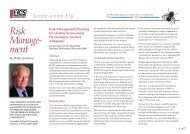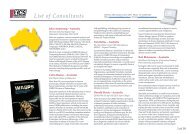Manual for Diagnosis of Screw-worm Fly - xcs consulting
Manual for Diagnosis of Screw-worm Fly - xcs consulting
Manual for Diagnosis of Screw-worm Fly - xcs consulting
Create successful ePaper yourself
Turn your PDF publications into a flip-book with our unique Google optimized e-Paper software.
A <strong>Manual</strong> <strong>for</strong> the <strong>Diagnosis</strong> <strong>of</strong> <strong>Screw</strong>-Worm <strong>Fly</strong><br />
6.2 Larvae<br />
Because the first two larval instars are relatively inconspicuous and occupy only two days<br />
<strong>of</strong> the 4-7 day larval development period, they are very rarely presented <strong>for</strong> diagnosis, and<br />
so the larval separation key is confined to the third (final) instar larva (Fig. 16). Reference<br />
to figures in key refers to scanning electron microscope photographs <strong>of</strong> mature larvae (Figs<br />
18-28).<br />
For further details <strong>of</strong> some <strong>of</strong> the larvae described in this key and other closely related species,<br />
see Erzinçlioglu (1987), Fuller (1932), Kitching (1976) and Liu and Greenberg (1989).<br />
1. Body with prominent projections <strong>of</strong> papillae on each segment (= ‘hairy maggot’) (A)<br />
………………...............................................................................................................…2<br />
- Body without prominent papillae except few on posterior segment (’smooth maggot’)<br />
(B) ………………..................................................................................................………4<br />
2. Very ‘hairy’ maggot, large larva (up to 17mm long); papillae present on both dorsal<br />
and ventral surfaces …………………..................................................…………………..3<br />
- Less ‘hairy’ maggot, small larva (




